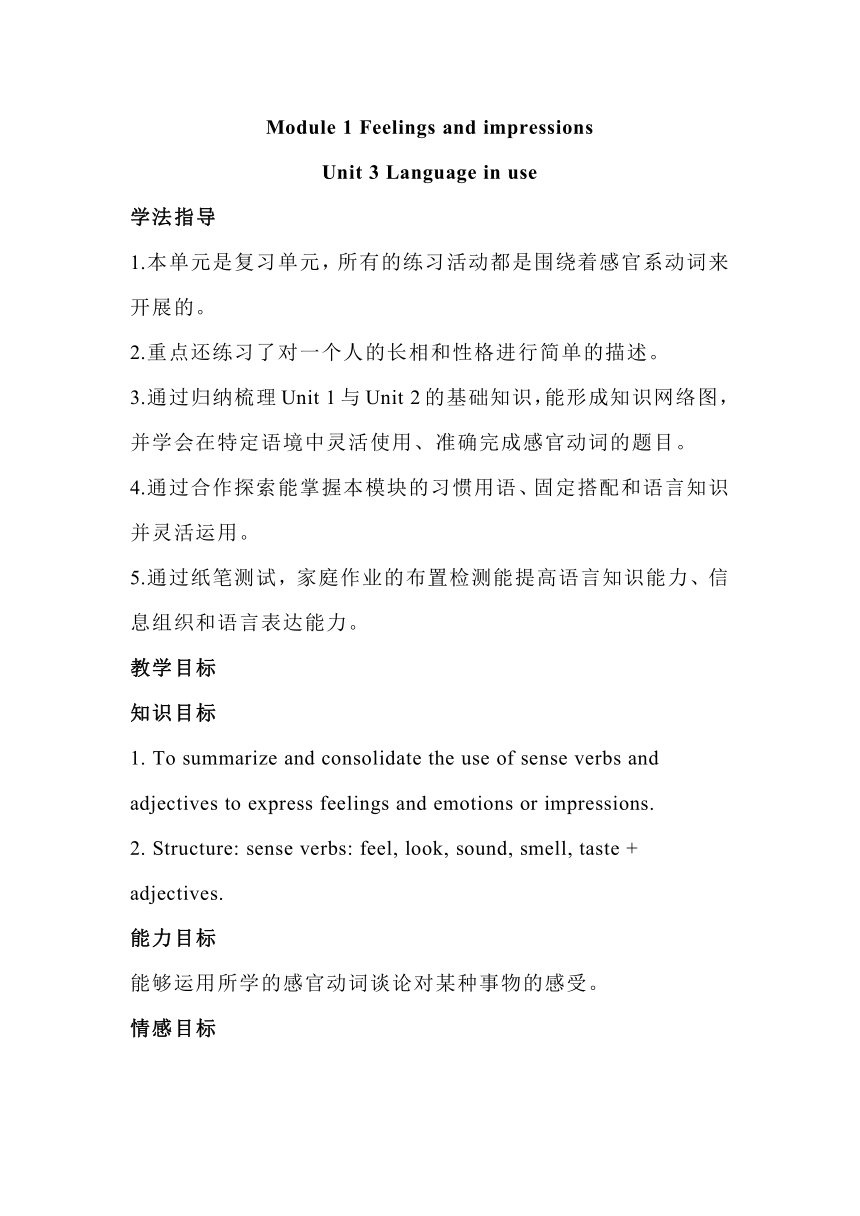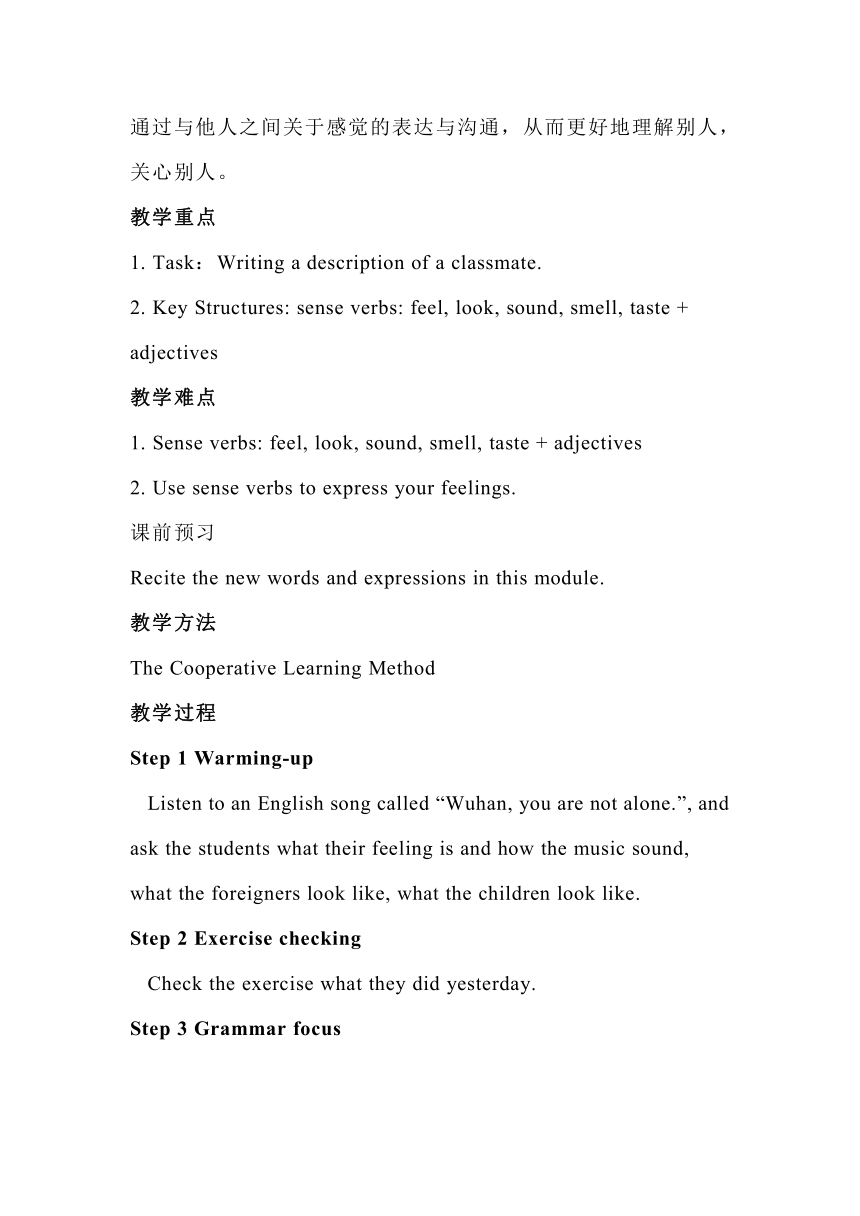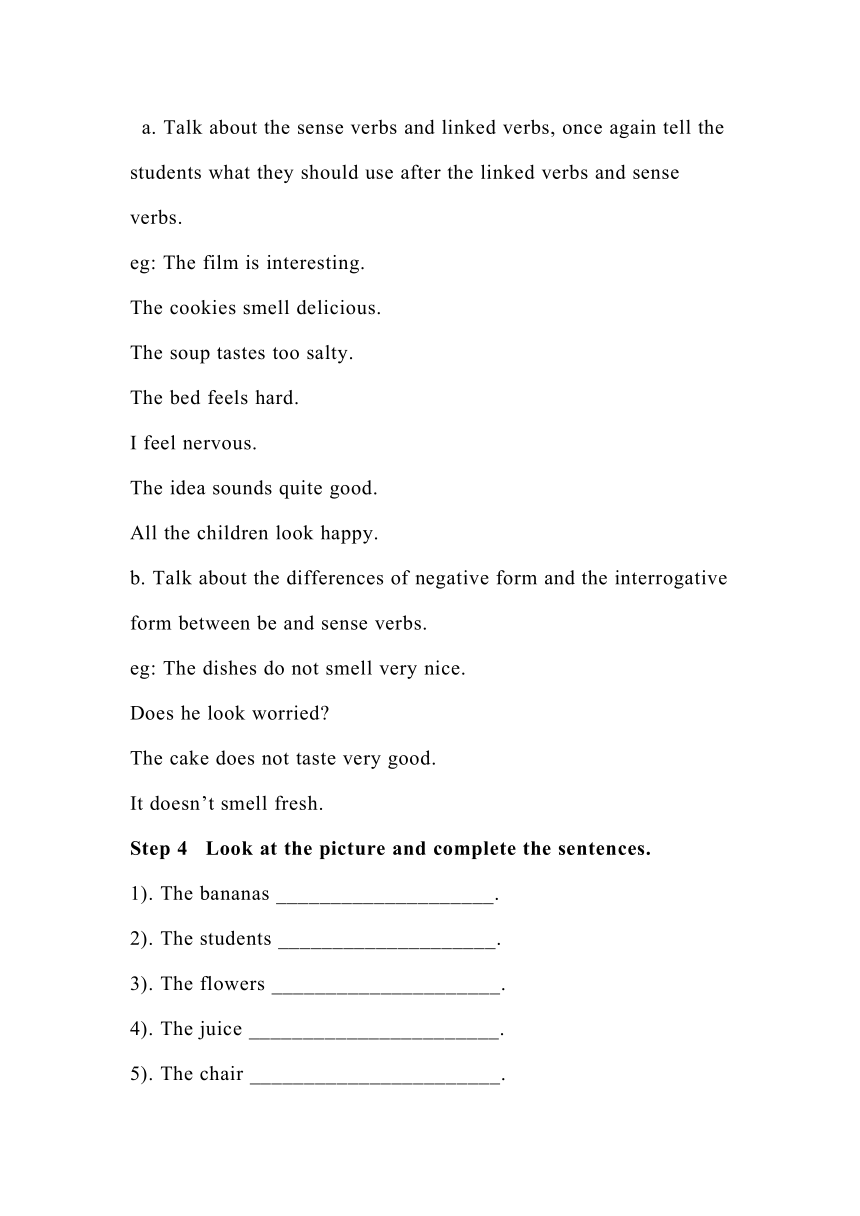Module 1 Feelings and impressions Unit 3教案
文档属性
| 名称 | Module 1 Feelings and impressions Unit 3教案 |  | |
| 格式 | zip | ||
| 文件大小 | 14.6KB | ||
| 资源类型 | 教案 | ||
| 版本资源 | 外研版 | ||
| 科目 | 英语 | ||
| 更新时间 | 2023-03-12 13:16:06 | ||
图片预览



文档简介
Module 1 Feelings and impressions
Unit 3 Language in use
学法指导
1.本单元是复习单元,所有的练习活动都是围绕着感官系动词来开展的。
2.重点还练习了对一个人的长相和性格进行简单的描述。
3.通过归纳梳理Unit 1与Unit 2的基础知识,能形成知识网络图,并学会在特定语境中灵活使用、准确完成感官动词的题目。
4.通过合作探索能掌握本模块的习惯用语、固定搭配和语言知识并灵活运用。
5.通过纸笔测试,家庭作业的布置检测能提高语言知识能力、信息组织和语言表达能力。
教学目标
知识目标
1. To summarize and consolidate the use of sense verbs and adjectives to express feelings and emotions or impressions.
2. Structure: sense verbs: feel, look, sound, smell, taste + adjectives.
能力目标
能够运用所学的感官动词谈论对某种事物的感受。
情感目标
通过与他人之间关于感觉的表达与沟通,从而更好地理解别人,关心别人。
教学重点
1. Task:Writing a description of a classmate.
2. Key Structures: sense verbs: feel, look, sound, smell, taste + adjectives
教学难点
1. Sense verbs: feel, look, sound, smell, taste + adjectives
2. Use sense verbs to express your feelings.
课前预习
Recite the new words and expressions in this module.
教学方法
The Cooperative Learning Method
教学过程
Step 1 Warming-up
Listen to an English song called “Wuhan, you are not alone.”, and ask the students what their feeling is and how the music sound, what the foreigners look like, what the children look like.
Step 2 Exercise checking
Check the exercise what they did yesterday.
Step 3 Grammar focus
a. Talk about the sense verbs and linked verbs, once again tell the students what they should use after the linked verbs and sense verbs.
eg: The film is interesting.
The cookies smell delicious.
The soup tastes too salty.
The bed feels hard.
I feel nervous.
The idea sounds quite good.
All the children look happy.
b. Talk about the differences of negative form and the interrogative form between be and sense verbs.
eg: The dishes do not smell very nice.
Does he look worried
The cake does not taste very good.
It doesn’t smell fresh.
Step 4 Look at the picture and complete the sentences.
1). The bananas ____________________.
2). The students ____________________.
3). The flowers _____________________.
4). The juice _______________________.
5). The chair _______________________.
6). The music ______________________.
Step 5 Put the words into the correct columns.
look like / be like的用法与区别
look like着重问人物长相,
look是看上去,即看上去是个什么样。
be like着重人的内在性格、人品,
是个什么样的人。
What does he look like (appearance)
What is he like (personality)
Step 6 Use the table in Activity 3 to ask and answer questions about the people.
your mum
A: What does your mum look like B: She’s tall and beautiful.
A: What is your mum like B: She’s friendly.
Have a try:
1. your dad
2. your maths / Chinese / music teacher
3. your uncle
4. your best friend
— What does he look like
— He is big and strong.
— What is he like
— He is nice.
Step 7 Complete the conversation with the correct form of the words in the box.
You need to use some of the words more than once.
Step 8 Complete the passage with the words in the box.
Step 9 Listen and complete the notes. What is the speaker complaining about
eg: the music / the room / the food / the drink / the people
Step 10 Around the world
Finish some exercise according to the short passage.
1). People in the West are quite ____ about their feelings.
2). Many people ____ each other when they meet.
3). People in the West are _______ and ________.
4). It is _____ for people to say “thank you” to others.
Step 11 Summary
1. Sense verbs: look, feel, taste, sound, smell + adj(后接形容词)
2. How to describe a person: appearance, personality, hobby and so on.
look like be like like …
Step 12 Homework
1. Think about one of your classmates
age, hair, hobbies, face, height, size
Write a description of him / her. Share it and ask someone to guess who he / she is.
2. Read the passages again and review all the notes and exercise in this module.
Unit 3 Language in use
学法指导
1.本单元是复习单元,所有的练习活动都是围绕着感官系动词来开展的。
2.重点还练习了对一个人的长相和性格进行简单的描述。
3.通过归纳梳理Unit 1与Unit 2的基础知识,能形成知识网络图,并学会在特定语境中灵活使用、准确完成感官动词的题目。
4.通过合作探索能掌握本模块的习惯用语、固定搭配和语言知识并灵活运用。
5.通过纸笔测试,家庭作业的布置检测能提高语言知识能力、信息组织和语言表达能力。
教学目标
知识目标
1. To summarize and consolidate the use of sense verbs and adjectives to express feelings and emotions or impressions.
2. Structure: sense verbs: feel, look, sound, smell, taste + adjectives.
能力目标
能够运用所学的感官动词谈论对某种事物的感受。
情感目标
通过与他人之间关于感觉的表达与沟通,从而更好地理解别人,关心别人。
教学重点
1. Task:Writing a description of a classmate.
2. Key Structures: sense verbs: feel, look, sound, smell, taste + adjectives
教学难点
1. Sense verbs: feel, look, sound, smell, taste + adjectives
2. Use sense verbs to express your feelings.
课前预习
Recite the new words and expressions in this module.
教学方法
The Cooperative Learning Method
教学过程
Step 1 Warming-up
Listen to an English song called “Wuhan, you are not alone.”, and ask the students what their feeling is and how the music sound, what the foreigners look like, what the children look like.
Step 2 Exercise checking
Check the exercise what they did yesterday.
Step 3 Grammar focus
a. Talk about the sense verbs and linked verbs, once again tell the students what they should use after the linked verbs and sense verbs.
eg: The film is interesting.
The cookies smell delicious.
The soup tastes too salty.
The bed feels hard.
I feel nervous.
The idea sounds quite good.
All the children look happy.
b. Talk about the differences of negative form and the interrogative form between be and sense verbs.
eg: The dishes do not smell very nice.
Does he look worried
The cake does not taste very good.
It doesn’t smell fresh.
Step 4 Look at the picture and complete the sentences.
1). The bananas ____________________.
2). The students ____________________.
3). The flowers _____________________.
4). The juice _______________________.
5). The chair _______________________.
6). The music ______________________.
Step 5 Put the words into the correct columns.
look like / be like的用法与区别
look like着重问人物长相,
look是看上去,即看上去是个什么样。
be like着重人的内在性格、人品,
是个什么样的人。
What does he look like (appearance)
What is he like (personality)
Step 6 Use the table in Activity 3 to ask and answer questions about the people.
your mum
A: What does your mum look like B: She’s tall and beautiful.
A: What is your mum like B: She’s friendly.
Have a try:
1. your dad
2. your maths / Chinese / music teacher
3. your uncle
4. your best friend
— What does he look like
— He is big and strong.
— What is he like
— He is nice.
Step 7 Complete the conversation with the correct form of the words in the box.
You need to use some of the words more than once.
Step 8 Complete the passage with the words in the box.
Step 9 Listen and complete the notes. What is the speaker complaining about
eg: the music / the room / the food / the drink / the people
Step 10 Around the world
Finish some exercise according to the short passage.
1). People in the West are quite ____ about their feelings.
2). Many people ____ each other when they meet.
3). People in the West are _______ and ________.
4). It is _____ for people to say “thank you” to others.
Step 11 Summary
1. Sense verbs: look, feel, taste, sound, smell + adj(后接形容词)
2. How to describe a person: appearance, personality, hobby and so on.
look like be like like …
Step 12 Homework
1. Think about one of your classmates
age, hair, hobbies, face, height, size
Write a description of him / her. Share it and ask someone to guess who he / she is.
2. Read the passages again and review all the notes and exercise in this module.
同课章节目录
- Module 1 Feelings and impressions
- Unit 1 It smells delicious.
- Unit 2 I feel nervous when I speak Chinese .
- Unit 3 Language in use
- Module 2 Experiences
- Unit 1 I've also entered lots of speaking competi
- Unit 2 They have seen the Pyramids.
- Unit 3 Language in use
- Module 3 Journey to space
- Unit 1 Has it arrived yet?
- Unit 2 We have not found life on any other planet
- Unit 3 Language in use
- Module 4 Seeing the docto
- Unit 1 I haven't done much exercise since I got m
- Unit 2 We have played football for a year now
- Unit 3 Language in use
- Module 5 Cartoons
- Unit 1 It's time to watch a cartoon.
- Unit 2 Tintin has been popular for over eighty yea
- Unit 3 Language in use
- Revision module A
- Module 6 Hobbies
- Unit 1 Do you collect anything ?
- Unit 2 Hobbies can make you grow as a person.
- Unit 3 Language in use
- Module 7 Summer in Los Angeles
- Unit 1 Please write to me and send me some photos
- Unit 2 Fill out a form and come to learn English
- Unit 3 Language in use
- Module 8 Time off
- Unit 1 I can hardly believe we are in the city ce
- Unit 2 We thought somebody was moving about
- Unit 3 Language in use
- Module 9 Friendship
- Unit 1 Could I ask if you've mentioned this to he
- Unit 2 I believe that the world is what you think
- Unit 3 Language in use
- Module 10 On the radio
- Unit 1 I hope that you can join us one day
- Unit 2 It seemed that they were speaking to me in
- Unit 3 Language in use
- Revision module B
